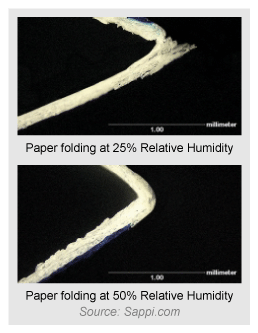It’s no surprise when newcomers to print finishing are thwarted by its hidden complexity. The simplest of folding jobs can generate all sorts of problems and questions. Heck, after 35 years working around bindery equipment I too am often surprised. When I encounter “simple” paper folding problems with no solution it reminds me what it was like to be an apprentice.
 So why does it get so complicated and what can we do to simplify things? After all, most printers work with paper that varies just several thousandths of an inch in thickness.
So why does it get so complicated and what can we do to simplify things? After all, most printers work with paper that varies just several thousandths of an inch in thickness.
Much of this print finishing difficulty stems from paper. Paper is complex far beyond its simple appearance. The oldest known sheet of paper dates from around 179 BC in China. After more than 2,000 years of making paper, you’d think we’d have solved all its mysteries. Yet as modern engineers, chemists, and scientists create new methods of manufacturing, the mysteries deepen!
When we look at the components of paper, it’s easier to understand why so many problems can arise.
Paper is made of cellulose fibers found in wood pulp and some papers include cotton fibers. Sizing is a filler that reduces paper’s tendency to absorb water, thus making it possible for inks to stay on the surface and dry. Calcium carbonate or other clay coatings are added in various amounts for glossiness. Water is a major ingredient as are any of dozens of chemicals. Colored papers contain dyes or pigments. Recycled papers include material recovered from used paper.
The size and orientation of fibers will affect paper folding and finishing performance. The dimensions of pulp fibers depend on the species and origin of the tree and can vary within the individual tree. It’s also interesting to note there are several theories about the way paper fibers bond together.
In the article What Holds Paper Together on nature.com the authors say, “Several mechanisms have been suggested to play a significant role in forming the fibre-fibre bonds that lead to the fibre network that we call paper. In the past, the following possible bonding mechanisms were considered: hydrogen bonds, mechanical interlocking, electrostatic interactions, inter-diffusion of cellulose molecules, and van der Waals forces. More recently, micro-compressions, capillary bridges, and stress due to the drying process have been under discussion. What is agreed is that all of these mechanisms contribute in some way to bonding two pulp fibres together. It is still not clear, however, which of these mechanisms dominates or if an interplay of several mechanisms is relevant.”
Remember, they’re only talking about the physics and chemistry of what bonds two paper fibers together. Now let’s add the countless variations in the manufacturing process which affect the performance of paper:
- Coating thickness. More coating might print better with a higher gloss but it could be harder to fold.
- Thicker coatings are more susceptible to cracking.
- Treatment process of pulp
- Bleaching
- The bond between paper base and the coating.
- Fiber content. High fiber content adds more stability to a sheet than low-fiber products such as triple-coated or recycled stocks.
Now the paper reaches the press room where we add inks, coatings, and varnishes with various saturation and coverage. The printing process makes paper less flexible, more brittle, and harder to finish. If the printed sheet happens to go through a dryer, it becomes even more brittle.
When we print on paper we introduce chemical processes that are not fully understood. Inks, coatings, and varnishes all bond to the paper and to each other in complicated ways. A minor change in a microscopic component of the printed piece can totally change how the printed job will run when it gets to the bindery. An ink supplier changes the recipe to their ink and now a j ob you’ve run many times before is scuffing on the folding machine or scratching on the saddle stitcher.
ob you’ve run many times before is scuffing on the folding machine or scratching on the saddle stitcher.
Next we have the environment in which relative humidity (RH) plays a huge role. A low RH can contribute to more occurrences of static problems. Low RH also contributes to fiber cracking problems.
These two images (right) from Sappi Paper’s Folding and Creasing show the powerful effect of working with the proper humidity levels. At 25% RH, the test paper splits. At 50% RH it folds fine. Of course you also need to use a creasing tool to fold papers heavier than a text-weight if you want to avoid fiber cracking. It always pays to be mindful of RH levels for best results.
When you look at all the variables, it’s enough to make you run for the hills. But never fear; there are some basic things you can do to keep things on track. We’ll touch on those in next week’s Bindery Success™ article.
In the meantime feel free to share your questions or stories below!


